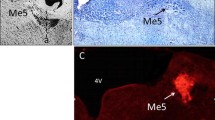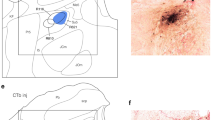Abstract
Recently, we showed that extra-trigeminal axons, originating from the hypoglossal nucleus, travel with the infraorbital division of the trigeminal nerve (ION), which is known to innervate the rat mystacial pad. Dil was monolaterally injected into the rat XII nucleus to analyse the peripheral distribution of hypoglossal axons to the mystacial pad, to evaluate their involvement in facial sensory–motor control. Electromyographic responses of mystacial pad motor units to electrical stimulation of the ION were recorded, along with the evoked responses to electrical stimulation of the ipsilateral XII nucleus. The results showed that hypoglossal axon terminals target the ipsilateral extrinsic musculature of the mystacial pad, but they do not have any contact with the intrinsic muscles. ION electrical stimulation increased electromyographic activity in the ipsilateral pad extrinsic muscles, even following VII nerve transection. Hypoglossal nucleus electrical stimulation induced field potentials and monosynaptic responses in the same motor units that persisted even following VII nerve transection, these disappearing after cooling the ION. We suggest that the small hypoglossal neurons projecting to the extrinsic musculature of the mystacial pad are part of a hypoglossal–trigeminal loop that participates in the sensory–motor control of the rat vibrissae system.





Similar content being viewed by others
References
Aldes LD (1980) Afferent projections to the hypoglossal nuclei in the rat and cat. Anat Rec 196:7A
Berg RW, Kleinfeld D (2003) Rhythmic whisking by rat: retraction as well as protraction of the vibrissae is under active muscular control. J Neurophysiol 89:104–117
Berthoud HR, Kressel M, Neuhuber WL (1992) An anterograde tracing study of the vagal innervation of rat liver, portal vein and biliary system. Anat Embryol 186:431–442
Borke R, Nau ME, Ringler RL Jr (1983) Brain stem afferents of hypoglossal neurons in the rat. Brain Res 269:47–55
Borke R, Nau ME (1987) The ultrastructural morphology and distribution of trigemino-hypoglossal connections labeled with horseradish peroxidase. Brain Res 442:235–241
Bowden REM, Mahran ZY (1956) The functional significance of the pattern of innervation of the muscle quadratus labii superioris of the rabbit, cat and rat. J Anat 90:217–227
Brancatisano A, Davis P, van der Touw T, Wheatley JR (1999) Effect of upper airway negative pressure on proprioceptive afferents from the tongue. J Appl Physiol 86:1396–1401
Brecht M, Preilowski B, Merzenich MM (1997) Functional architecture of the mystacial vibrissae. Behav Brain Res 84:81–97
Carvell GE, Simons DJ (1990) Biometric analyses of vibrissal tactile discrimination in the rat. J Neurosci 10:2638–2648
Dauvergne C, Pinganaud G, Buisseret P, Buisseret-Delmas C, Zerari-Mailly F (2001) Reticular premotor neurons projecting to both facial and hypoglossal nuclei receive trigeminal afferents in rats. Neurosci Lett 311:109–112
Dörfl J (1982) The musculature of the mystacial vibrissae of the white mouse. J Anat 135:147–154
Dörfl J (1985) The innervation of the mystacial region of the white mouse. A topographical study. J Anat 142:173–184
Erzurumlu RS, Killackey HP (1979) Efferent connections of the brainstem trigeminal complex with the facial nucleus of the rat. J Comp Neurol 188:75–86
Fanselow EE, Nicolelis MAL (1999) Behavioral modulation of tactile responses in the rat somatosensory system. J Neurosci 19:7603–7616
Fee MS, Mitra PP, Kleinfeld D (1997) Central versus peripheral determinants of patterned spike activity in rat vibrissae cortex during whisking. J Neurophysiol 78:1144–1149
Gandieva SC, Burke D (1994) Does the nervous system depend on kinaesthetic information to control natural limb movements. In: Cordo P, Harnard S (eds) Motor control. Cambridge University Press, New York, pp 12–30
Gao P, Bermejo R, Zeigler HP (2001) Vibrissa deafferentation and rodent whisking patterns: Behavioral evidence for a central pattern generator. J Neurosci 21:5374–5380
Hammerschlag PE (1999) Facial reanimation with jump interpositional graft hypoglossal–facial anastomosis and hypoglossal facial anastomosis: evolution in management of facial paralysis. Laringoscopie 109(Suppl 90):1–23
Hattox AM, Li Y, Keller A (2003) Serotonin regulates rhythmic whisking. Neuron 39:343–352
Hattox AM, Priest CA, Keller A (2002) Functional circuitry involved in the regulation of whisker movements. J Comp Neurol 442:266–276
Honig MG, Hume RI (1989) Dil and DiO: versatile fluorescent dyes for neuronal labeling and pathway tracing. Trends Nuerosci 12:333–341
Klein BG, Rhoades RW (1985) Representation of whisker follicle intrinsic musculature in the facial motor nucleus of the rat. J Comp Neurol 232:55–69
Kleinfeld D, Berg RW, O’Connor SM (1999) Anatomical loops and their electrical dynamics in relation to whisking by rat. Somatosens Motor Res 16:69–88
Mameli O, Melis F (1993) Olfactory modulation of hypoglossal neuron activity. Arch Ital Biol 131:201–212
Mameli O, Melis F, De Riu PL (1994) Visual and vestibular projections to tongue motoneurons. Brain Res Bull 33:7–16
Mameli O, Melis F, Caria MA, Podda MV, Solinas A, Becciu A, De Riu PL (1995) Olfactory influence on tongue activity. Arch Ital Biol 133:273–288
Mameli O, Pellitteri R, Russo A, Stanzani S, Caria MA, De Riu PL (2006) Role of trigeminal nerve in regrowth of hypoglossal motoneurons after hypoglossal–facial anastomosis. Acta Oto-Laryngol 126:1334–1338
Mameli O, Russo A, Borke R, Melis F, Caria MA, Pellitteri R, Tavera C, Stanzani S (2003) Olfactory–hypoglossal connections. Pflügers Arch 445:705–715
Mameli O, Tolu E (1986) Somatosensory input from forelimb nerves to the hypoglossal neuron. Exp Neurol 94:757–766
Nguyen Q-T, Kleinfeld D (2005) Positive feedback in a brainstem tactile sensorimotor loop. Neuron 45:447–457
Nicolelis MA, Ghazanfar AA, Faggin BM, Votaw S, Oliveira LM (1997) Reconstructing the engram: simultaneous, multisite, many single neuron recordings. Neuron 18:529–537
Nicolelis MAL, Baccala LA, Lin RCS, Chapin JK (1995) Sensorimotor encoding by synchronous neural ensemble activity at multiple levels of the somatosensory system. Science 268:1353–1358
Paxinos G, Watson C (1997) The rat brain in stereotaxic coordinates. Academic, Sydney
Renehan WE, Munger B (1986) Degeneration and regeneration of peripheral nerve in the rat trigeminal system. I. Identification and characterization of multiple afferent innervation of the mystacial vibrissae. J Comp Neurol 246:129–145
Rice FL, Fundin BT, Arvidsson J, Aldskogius H, Johansson O (1997) Comprehensive immunofluorescence and lectin binding study of the innervation of vibrissae follicle sinus complexes on the mystacial pad of the rat. J Comp Neurol 385:149–184
Rice FL, Mance A, Munger B (1986) A comparative light microscopic analysis of the sensory innervation of the mystacial pad. I. Innervation of the vibrissal follicle-sinus complexes. J Comp Neurol 252:154–174
Sachdev RHS, Berg RW, Chompney G, Kleinfeld D, Ebner FF (2003) Unilateral vibrissa contact: Changes in amplitude but not the timing of vibrissa movement. Somatosens Motor Res 20:162–169
Sachdev RNS, Sato T, Ebner FF (2002) Divergent movement of adjacent whiskers. J Neurophysiol 87:1440–1448
Semba K, Egger DM (1986) The facial “motor” nerve of the rat: control of vibrissal movement and examination of motor and sensory components. J Comp Neurol 247:144–158
Tamamaki N (1997) Organization of the entorhinal projection to the rat dentate gyrus revealed by Dil anterograde labeling. Exp Brain Res 116:250–258
Travers JB (1995) Oromotor nuclei. In: Paxinos G (ed) The rat nervous system. Academic, New York, pp 239–255
Travers JB, Norgren R (1983) Afferent projections to the oral motor nuclei in the rat. J Comp Neurol 220:280–298
Waite PME, Jacquin MF (1992) Dual innervation of the rat vibrissa: responses of trigeminal ganglion cells projecting throughout deep or superficial nerves. J Comp Neurol 322:233–245
Waite PME, Tracey DJ (1995) Trigeminal sensory system. In: Paxinos G (ed) The rat nervous system. Academic, New York, pp 705–724
Watson CRR, Sakai S, Armstrong W (1982) Organization of the facial nucleus in the rat. Brain Behav Evol 20:19–28
Welker WI (1964) Analysis of sniffing of the albino rat. Behavior 22:223–244
Wineski LE (1983) Movements of the cranial vibrissae in the Golden Hamster (Mesocricetus auratus). J Zool Lond 200:261–280
Woodhams PL, Terashima T (2000) Aberrant trajectory of entorhino-dentate axons in the mutant Shaking Rat Kawasaki: a Dil-labelling study. Eur J Neurosci 12:2707–2720
Zerari-Mailly F, Pinganaud G, Dauvergne C, Buisseret P, Buisseret-Delmas CJ (2001) Trigemino-reticulo-facial and trigemino-reticulo-hypoglossal pathways in the rat. J Comp Neurol 429:80–93
Acknowledgements
We thank Messrs. G. Sanna, F. Tavera, A. Monti, G. Mulliri, and D. Zanetti of Sassari University, as well as Mr. S. Bentivegna and Dr. D. Lo Furno of Catania University for their technical assistance.
Author information
Authors and Affiliations
Corresponding author
Rights and permissions
About this article
Cite this article
Mameli, O., Stanzani, S., Russo, A. et al. Hypoglossal nuclei participation in rat mystacial pad control. Pflugers Arch - Eur J Physiol 456, 1189–1198 (2008). https://doi.org/10.1007/s00424-008-0472-y
Received:
Revised:
Accepted:
Published:
Issue Date:
DOI: https://doi.org/10.1007/s00424-008-0472-y




